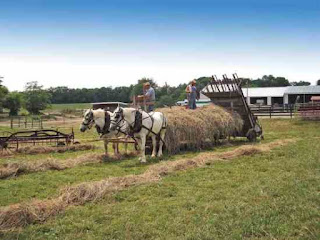In our previous blog we looked at tea and jam as a way of saving a bit of summer to use year round. Now we will look at how what we can do now, in the summer, so we can have a nice breakfast in the winter with a hot cup of tea with milk and butter or cream on blueberry muffins. Sound good? Well historically you had to plan and prepare for that.
The key to that preparation can be seen in the field in the photo above. What follows are some details about the changing nature of preserving summer's harvest of grass for the winter.
I took this photo on the first day of summer, June 21, 2019, from the Saco Valley Overlook. To map the location of the viewpoint click here. To see the street view click here.
The long green stripes seen on the right are known as windrows, hay that has been cut, dried and raked into rows.
The photo below was taken June 29 and shows that right field has been cleared of the cut hay.
The dark stains show that the field has been manured. A photo taken July 5 shows the right field has grown green and the left field has been cut and bailed into round bales.
A closer view shows the round bales on the left of the truck, and a wagon full of square bales in the background.
Mowing hay is an important part of keeping the view open. It is also a way of preserving the food value of grass so livestock can eat it over the winter. The painting below shows the finished product heading towards the barn. It is by the artist Albert Bierstadt. Titled Haying, Conway Meadows, its shows from right to left the southern end of the Moats, and the Three Sister, and the peak of Chocorua as seen near the old ford near the athletic fields near Kennett High School.
There are remnants of horse powered hay equipment displayed as lawn ornaments all over Conway. Here is a horse powered sickle bar mower.
Here is a photo of a similar machine with the sickle bar lowered and the farmer sitting on the sulky seat.
At the Hobbs Tavern in West Ossipee is a horse drawn machine known as a tedder that reproduces the hand powered operation of fluffing the hay with a pitchfork to help the hay dry in the sun.
Here is a sketch showing how this one machine does the work of eight men.
Here is a photo of a farmer using the tedder.
The tedder can toss the hay as high as three feet in the air before it returns to the ground.
The next step is to rake the dried hay into windrows. The Hobbs Tavern "open air museum" features a slide delivery rake used to roll the cut hay into windrows.
Here is an example of a farmer using a side delivery rake.
This photo shows the complicated gears involved in making it work.
The next step is to pick up the hay from the windrows and to put it in the wagon. Here is a view of it being done by a horse powered machine known as a hay loader...
... with a team of horses pulling the wagon and loader over the windrows.
Again, the idea behind the machine was to use gears and gizmos to reproduce the action of hand powered, man powered pitch fork to toss it up on the wagon.
Each of the six wooden bars are fitted with mechanical fingers and the gears pull the hay from the windrow up the loader ramp before cascading over the top onto the wagon.
The hay is then dumped over the loader onto the top of the load on the wagon. At the barn a hay fork is set into the hay on the wagon.
Then through a set of pulleys, ropes and trolley rails a large amount of hay can be lifted high into the air, pulled sideways along the ridge of the barn and dropped onto the hayloft.
The final step was to spread manure to fertilize the field for the next crop of hay.
Again, the idea was to mechanize the use of a pitchfork to spread the manure onto the fields.
Here is an example of a manure spreader displayed along the side of the road in the Mount Washington Valley.
For more details on this or any other historical subject in the White Mountains, contact us at the Conway Public Library's Henney History Room.

























No comments:
Post a Comment